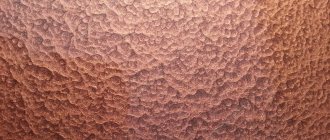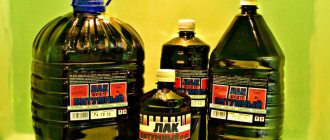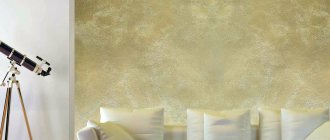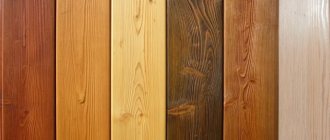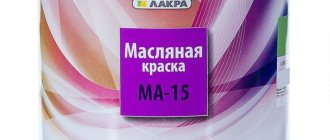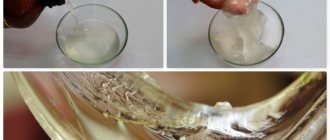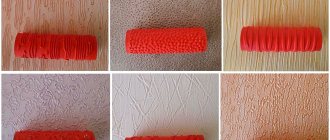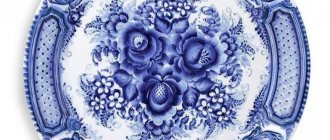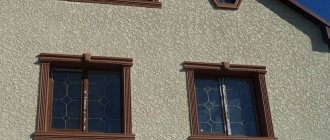Types of epoxy-based compounds and their properties
Epoxy paints are two-component - resin and hardener, powder, aerosol (used mainly for painting car parts). For domestic needs, mainly compositions based on cold-curing epoxy resin are used. Such paints harden after a day or more without additional exposure to the surface.
Manufacturing requires high-strength coatings, and these can only be obtained from hot-curing epoxy resin. Epoxy powder paints use a hot-curing resin, while two-component and aerosol paints use a cold-curing resin.
Important! The difference between the compositions is significant. During hot curing (polymerization), the network of paint molecules is thicker and stronger; during cold curing, it (the network) is thinner and does not have such strong molecular bonds.
The general properties of epoxy paints distinguish them from other coatings:
- create a durable surface.
- Suitable for painting both floors and walls.
- are waterproof, so can be used as waterproofing in bathrooms and for painting swimming pools.
- resistant to mechanical stress.
- resist various aggressive chemicals.
- have excellent adhesion to concrete, plastic and metal surfaces.
- Suitable for finishing floors in residential and industrial premises.
- a rich color palette and many textures allow you to embody interesting design ideas.
Aerosol paints are most often acrylic epoxy. They are characterized by high anti-corrosion properties, resistance to various chemical influences, including aggressive ones (suitable for outdoor use), and a high degree of self-cleaning (dust and dirt do not stick to the painted surface). Aerosol acrylic epoxy compounds form a durable glossy coating that is resistant to scratching and chipping.
There are several varieties of epoxy powder paints, which differ from each other in their technical characteristics:
- Standard. The polymerization process occurs in a chamber at a temperature of +220°C in the first 10 minutes of treatment.
- Low temperature. The polymerization process occurs in a chamber at a temperature of +180°C in the first 20 minutes.
- Polyester. They have high wear resistance, a rich palette of colors, textures (metallic, antique, clear varnish), gloss levels, and are low-toxic. They are used to provide maximum surface protection from friction and often replace primers.
- Epoxy-polyester. Such paints are inexpensive, have average abrasion resistance, are resistant to sunlight (do not turn yellow), high temperatures, scratching and other mechanical stress, and are resistant to aggressive chemical solvents and rust. At the same time, they are decorative - they are used as film coatings for precious metals and perfume bottles.
Varieties and selection criteria
Two-component paint
Epoxy enamels are classified by release form, and then by composition. This makes it easier to determine which option is best to use in a particular case.
Two-component epoxy-based paints are preferred for industrial purposes, as they are more difficult to work with. However, in the case of epoxy compounds, mixing is not difficult. The mixture is tinted, although there are exceptions. Two-component mixtures are characterized by very high wear resistance. Floors, and even more so walls, painted with such enamel can last for several decades.
The compositions are distinguished according to their intended purpose.
- For concrete – forms a very dense, wear-resistant top layer. Suitable for interior and exterior work – in open areas.
- For metal – prevents corrosion, can be used on already damaged metal. It can withstand heat, so it is used for painting radiators and electric heaters.
- Epoxy paint for wood - forms a waterproof film and suppresses the growth of fungi and mold. Protects wooden structures from insect pests.
Two-component mixtures are very economical. You can cook in small portions. The remaining volume is stored in an airtight container for up to 6 months.
Aerosol – one-component. Sold in cans, sprayed using a pistol nozzle. The enamel is applied in a thin layer. It is very elastic and decorative. Aerosol paints are produced in matte, glossy, shiny and even with a pearlescent effect. Aerosol mixtures are not so resistant to wear and are more often used for finishing walls and ceilings.
Powder - a special form, includes epoxy resin, pigments and hardener. However, it requires heat to polymerize and harden. Enamel is applied to metal products - steel doors, car bodies and parts, in special heat chambers. There are 2 types of paint:
- standard – curing is carried out at a temperature of +220°C for 10 minutes;
- low temperature – hardens at +180°C for 20 minutes.
Powder paints are not used in everyday life.
Compound
Epoxy paints consist of diane oligomers (molecular weight 1400 - 2500), modifiers, hardener, fillers and pigments, additional substances - hardening accelerators, viscosity and spreading regulators.
Epoxy paint composition
Two-component compositions for manual self-painting of metal parts consist of approximately 40% fillers: flow regulators, modifiers, and pigments. Powder epoxy coatings (thermal insulation) - they are called compounds and are always applied only in a thick layer - almost never contain modifiers and contain up to 70% fillers with a low coefficient of thermal expansion. This is usually quartz, represented by dust, or fiberglass.
Features of the composition
Epoxy paints are made from resins. Thanks to this, they create a durable coating layer on the surface. These finishing materials also contain other components:
- thinner (needed for better dissolution and connection of components);
- pigments (for coloring in the desired color);
- hardeners (accelerate drying and affect the strength of the coating);
- binders (improves paint viscosity);
- fiberglass (to improve heat resistance).
The amount of certain components directly depends on the area in which the paint will be used. For example, for painting stoves, a thermal coating is used with a minimum amount of solvents, binders and the mandatory presence of glass fibers.
Depending on the form in which epoxy paint is produced, the following types are distinguished:
- powder;
- two-component;
- aerosol.
Scope of application
Epoxy polyester, acrylic epoxy and epoxy paints are widely used in various fields. They form different types of surfaces - completely non-slip, protective, fluorescent, matte, glossy, textured, quick-drying.
The following compositions are used to paint:
- travel accessories;
- household items;
- internal and external parts of passenger cars;
- electrical appliances;
- decorative garden figurines;
- office furniture;
- radiators, heaters;
- toys;
- floors and walls;
- facades;
- containers with chemicals.
Epoxy paint can be used to paint concrete bathroom floors. This will protect them from moisture, and the neighbors below from leaks. In addition, this is an excellent alternative to ceramic tiles. This coating can be used to protect coils and other metal parts in bathrooms and kitchens from corrosion. If you cover wood with this paint, it will be reliably protected from rot and insects.
Properties and composition of epoxy enamels
Epoxy enamels have the properties of epoxy resins. These resins are a synthetic oligomer, which is currently used in all existing areas of industry. Epoxy resins themselves are not used anywhere in their pure form; they receive their valuable and unique properties after the process of combining with a hardener and the complete completion of the polymerization process. Depending on the combination and proportion of different types of resins with hardeners, materials with different properties are obtained, from rigid, like metal, to flexible, rubber-like materials. Depending on the temperature and type of hardener used, epoxy resin is divided into hot and cold curing resins.
Paint and varnish coatings, which are based on epoxy resins, have excellent adhesion ability to painted metal surfaces, wood, concrete and other types of painted surfaces. In addition, epoxy paints are characterized by increased hardness, chemical resistance and high elasticity.
Epoxy paint is a durable and strong coating that extends the life of the surface being painted, such as flooring, ensuring a great appearance over time. This type of paint perfectly resists aggressive external irritants and influences - for example, chemical substances such as acids, alkalis, salt solutions, fuels and lubricants, withstands heavy loads and has high adhesion to stone building materials containing binders, various fillers size and water, for example, concrete.
Another distinctive feature of epoxy paints and varnishes is their waterproofing property.
Advantages of waterproofing paints:
1). Self-healing, restoration – i.e. Under mechanical pressure on such paint, it bends, but does not collapse, eventually restoring its position. This possibility is realized due to the presence of furyl, perchlorovinyl, epoxy and similar resins consisting of synthetic compounds.
2). A surface painted with this kind of enamel “breathes.” That is, if you paint rooms with such paint that are deprived of light and have a high moisture content, for example, basements, then the walls, thanks to such paint, will breathe without creating additional condensation.
3). Easy to use. In order to apply paintable waterproofing to the surface, before doing this it is necessary to paint the surface with a bitumen or polymer composition; for this it is enough to use a regular roller, brush, mop or pouring with a comb. Staining must be carried out until a continuous, integral film is formed.
4). Corrosion protection. Surfaces that are painted with waterproofing epoxy enamels reliably resist corrosion.
Operating rules
Epoxy resin is a synthetic polymer. When combined with a hardener, a thermochemical reaction occurs, releasing a large amount of heat. Therefore, you need to work with two-component epoxy paints carefully, always following safety rules:
- Use special clothing when preparing and applying paint - gloves, overalls and a respirator are required. It's nice to have glasses too.
- Use special sticks to connect the composition. Never use food utensils.
- If paint does get on your skin, remove it immediately with denatured alcohol or wash with warm water and soap. If the composition hardens, it will be difficult to remove.
- Provide ventilation - open a window in the room where painting is carried out.
- Store cans of paint and hardener at a temperature not exceeding 40°C, away from heat sources and sunlight.
Important! Before painting, it is necessary to carry out a series of works to remove the old coating, clean and degrease the surface. If there are obvious chips and potholes, they must be repaired.
Two-component formulations
This type of epoxy composition is the most common. They can be used not only in industry, but also at home. They come in the form of two separate components that need to be mixed before starting work.
The binder is a mixture of epoxy resins, which are the basis of the paint. They have a liquid, flowing, homogeneous consistency. Hardener is a component without which the coating will not harden on the surface. It usually comes in powder form. In addition, the paint contains coloring pigments.
Based on the surface for which the finishing material is intended, there are the following types:
- epoxy paint for concrete – creates a durable wear-resistant layer. Used for flooring both indoors and outdoor concreted areas. Two-part epoxy enamels are available in a variety of colors, the most common being brown, gray and black;
- epoxy paints for metal – protect the surface from corrosion. In everyday life they are used for processing fences, fences, gates, elements of heating systems;
- epoxy wood paints – prevent rotting processes and surface damage by pests and fungi. Used for painting the facades of houses, gazebos and for interior finishing of floors.
Two-component epoxy paint for concrete, metal or wood is economical in use. This is explained by the fact that you can independently prepare the required amount of material, and the remainder will be stored for a long time until the next staining.
When working with such compositions, it is important to observe the proportions of mixing the components. This is necessary so that after drying the coating retains its protective properties for a long time.
Compositions for concrete
Epoxy paint for concrete floors is a qualitatively new type of paint and varnish materials. If classic compositions based on epoxy resins are never mixed with water, since they become cloudy and lose some of their properties, then in the case of concrete paint, they add not ordinary water, but distilled water, resulting in an epoxy dispersion.
A striking representative of this type of paintwork material “Epostone” is a water-based epoxy primer-enamel for concrete floors. Among its technical characteristics it is worth highlighting the following:
- excellent adhesion to concrete;
- high wear resistance;
- resistance to non-concentrated chemicals;
- environmental cleanliness;
- weather resistance (allowed for outdoor use).
The most important positive quality of such enamel is its ability to be used on wet concrete. In addition to saving time, the technical characteristics of the coating itself are improved. Epoxy resin prevents moisture from evaporating from its surface. After gaining working strength, dusting of the surface is completely eliminated.
Epoxy paint: types and features
Epoxy enamel is characterized by its high resistance to mechanical stress, so it is applicable for different types of surfaces. You can find different shades of paint on sale, which allows you to choose the appropriate coloring option.
Its inherent characteristic of creating a protective layer against the effects of water allows the use of epoxy paint for metal. It dries quickly and is suitable for any type of finishing work.
The following types of products are distinguished:
- Two-component paint for metal;
- Aerosol;
- Powder.
The first type is the most common in use; it is often chosen for domestic needs. Before starting work, mix the two components.
Before starting work, mix the two components.
The aerosol type has the highest resistance to environmental influences; such an epoxy coating for metal will create a glossy effect and help it remain clean for a longer period of time, because the coloring composition has the property of self-cleaning, and scratch resistance also increases. It is easy to paint the surface with this product.
The aerosol type has the highest resistance to environmental influences.
The latter type is usually chosen for industrial application since drying requires the use of heating chambers.
Powder paint is usually chosen for industrial applications.
Preparatory work
There are two possible options for using epoxy primer-enamel on concrete - on a fresh concrete screed and on an old slab. Preparation processes vary.
In the first case, coloring is possible already 5 days after pouring. At this moment, the moisture content of the concrete is high enough, so the epoxy will penetrate deep into its pores, giving additional strength to the surface. In this case, leveling the floor is not required, but you will have to walk over it with a “helicopter” - a grinding machine - to remove the cement laitance and open the pores. If there is no helicopter, then the treatment needs to be done with a stiff brush. After this, thoroughly vacuum the surface.
If you are going to paint old concrete, you need to thoroughly prepare it - seal all the potholes (with epoxy putty) and remove any humps, if any. Then vacuum the surface. The moisture content of the old concrete pavement should not exceed 4%. Otherwise, the epoxy paint will begin to peel off pretty quickly.
Important! Potholes and cracks must be filled out, then priming is carried out and only after that puttying is carried out. The primer is prepared from the enamel primer that will be used for painting - it is diluted 10% with distilled water. After applying the primer layer, you must wait 12 hours to 24 hours for it to dry.
Aerosol epoxy compounds
Aerosol finishing materials are convenient to use for painting hard-to-reach places that cannot be reached with a brush or roller. Thanks to spraying, a perfectly even and thin layer of coating is created. It is for this reason that it is often used to paint cars.
Aerosol epoxy enamel for metal is not prone to smudges, it is elastic and does not crack when exposed to low temperatures. Manufacturers produce the following varieties of these paints and varnishes:
- glossy;
- matte;
- with the addition of mother of pearl.
Such paints for concrete and wood are not used due to the fact that their consumption is much greater than when processing with a conventional two-component composition.
Coloring instructions
The technology for applying epoxy primer-enamel to concrete is quite simple, but you must follow the instructions so as not to spoil the material:
- Thoroughly mix component A - epoxy resin with pigment and additives.
- Measure out the required amount of component A and mix it with component B (hardener). The ratio of parts is 100:17. Mixing time – no more than 3 and no less than 2 minutes. Let the mixture sit for about a quarter of an hour before starting work.
- Perform coloring.
Important! The lifespan of the finished paint is about 4 hours. Therefore, all work must be carried out quickly. The temperature of the base should not be lower than +15°C. The surface can be used in the range of -15 – +60°C.
Application area
Due to the many benefits of this foundation, it is used in various fields. It is used to paint automotive equipment, metal and plastic containers, floor coverings and facades. Street fences are decorated using these bases. Due to the low toxicity of the composition, it is often used for painting indoor parts. In order for the coating to last a long time, you need to properly prepare the surface before painting. If concrete is covered with paint, then painting work can be carried out after all layers have dried. This will increase the adhesiveness of the substance to the surface, which means the coating will be stronger. The previous layer of enamel must be removed from the metal and sanded so that the coating does not swell. Ordinary sandpaper or a steel brush will help with this. The next stage is degreasing. An ordinary solvent will do the job. The cleaned surface will be uneven, so you need to prime it. After this, the substance will be distributed in an even thin layer. Now you can start painting. You need to choose a tool. This can be a roller, brush or aerosol. An aerosol is used for painting cars, a brush is used for hard-to-reach areas, and a roller is used for large areas. The coating is applied in several layers, each of which is applied after the previous one has completely dried. The enamel dries within 12 hours after application. Although the substance is not overly toxic, it still emits poisons that are dangerous to inhale. Therefore, all work must be carried out equipped with a respirator, protective clothing and gloves. After applying several layers, the room must be ventilated or painted outdoors.
Painting a concrete floor
Painting metal parts Please note: Oil paint for wood
Manufacturers
In practical use, epoxy primer-enamel for Russian concrete floors has proven itself best. Excellent reviews about Elakor-ED paint - this is also a Russian brand. Both samples do not contain inert fillers, the presence of which reduces the cost of the material, but at the same time reduces its properties.
Excellent quality epoxy paints from manufacturers from the USA. They are the most environmentally friendly and safe. They cost a little more, but the quality is worth it. Among the most famous American manufacturers it is worth highlighting:
- Aervoe;
- Ktisis;
- Rocol;
- ITW Spraytec;
- Huntsman Advanced Materials.
The choice of epoxy paints on the construction market is large. Finding the right quality material at the right price is quite difficult. Therefore, before purchasing, analyze for what purposes you need such paint and varnish, evaluate your financial capabilities, and only after that go to the construction market. And never buy epoxy compounds from a market where it is impossible to maintain proper storage conditions.
"Epostat"
A separate type of EPC, which is very widely used in various fields, is the primer - Epostat enamel. This is a wear-resistant, chemically resistant 3-in-1 two-component epoxy enamel. It has increased resistance to chemicals, which makes it suitable for use in the petrochemical and gas industries, and in hydraulic structures.
This paintwork material is both an anti-corrosion primer, a rust converter and a wear-resistant paint. The main advantages of Epostat epoxy enamel are: fast drying (less than 4 hours), temperature resistance (-120 degrees - + 40 degrees), gasoline and oil resistance, resistance to salt and fresh water. Complete readiness of the painted surface for use is possible after 7 days. As a result of using this type of two-component epoxy-based paint on metal, a smooth, semi-glossy, completely uniform surface of the product is obtained. The consumption of primer and enamel per square meter is 160-200 g, which results in a layer of film 80-100 microns thick.
Technical data of Epostat primer enamel:
| Base material | Epoxy resin |
| Film appearance | Homogeneous semi-gloss surface |
| Mass fraction of non-volatile substances, % | 72 – 78 |
| Conditional viscosity according to V3-246 (nozzle 4), sec, not less | 50 |
| Drying time to degree 3 at t (20.0±0.5)°C, h, no more | 4 |
| Film strength upon impact, cm, not less | 50 |
| Film strength in bending, mm, no more | 2 |
| Resistance to static influence of water at (20.0±2)°С, h, not less | 72 |
| Film resistance to 3% sodium chloride solution, h, not less | 72 |
| Degree of grinding, microns, no more | 40 |
| Adhesion, point, no more | 1 |
Technology for working with epoxy paints
Before applying epoxy to the surface to be treated, the substance is prepared for work. That is, the main composition is mixed with the supplied catalyst-hardener. It becomes important to strictly adhere to the proportions of the components and thoroughly mix the mass . The further work procedure is as follows:
- The working surface of the metal is cleaned of dust and dirt. The existing layer of rust, fat and oil deposits is removed. Sanded if necessary.
- Prepared epoxy paint is applied. When working, you can use paint rollers, brushes or an additional spraying tool.
- The treated surface is left until the layer dries completely.
Advice. To thin epoxy paint that is too thick, it is not advisable to use pure solvents - they reduce moisture resistance and strength. To dilute the substance, the paint itself is used with a solvent already diluted in it.
Don't forget about personal safety precautions. When working with epoxy dyes, be sure to use protective equipment: a respirator mask, goggles and gloves. Remember that when the hardener and epoxy resin are combined, a large amount of heat begins to be released. If a catalyst is added to the resin too quickly, the substance may boil and become unusable.
If work is carried out indoors, ensure good ventilation. Epoxy components become safe for humans only after polymerization is completed. Before this process is completed, the resinous substance releases harmful fumes. And if the composition gets on the skin, severe allergic reactions are possible.
Painting features and safety precautions
Two-component formulations consisting of resin and hardener must be mixed in the proportion recommended by the manufacturer. In the process of their connection, a certain amount of heat and fumes harmful to the human body are released due to the passage of a thermochemical reaction.
Therefore, for safe work, the painter must:
- Availability of a respirator, overalls, gloves and safety glasses.
- Mandatory ventilation of the room.
In addition, hardeners pose a health hazard because they contain:
- carcinogens/mutagenicity;
- diluent allergens;
- toxic elements.
The consequences of improper painting work are occupational asthma, chemical pneumonia.
Do not use food utensils to mix the composition. If paint gets on your body, you should immediately clean the skin with denatured alcohol or white vinegar before the paint hardens.
Characteristics
Two-part epoxy paints are an excellent paint option when you need to create a strong, long-lasting protective layer. The painted surface can withstand mechanical stress and the influence of aggressive chemicals without damage. Due to their high resistance, epoxy paints are used in many areas, both for exterior painting of outdoor objects, where there are poor, unfavorable climatic conditions, and for interior use, for painting premises for various purposes.
To paint a concrete floor, it is best to choose epoxy paint, as it will last much longer than other types of paints and varnishes. And walls painted with two-component epoxy paint will be able to withstand washing with caustic detergents.
The characteristics of these compositions allow them to be used for painting metal, concrete, wooden surfaces and other materials. Using only epoxy paint you can paint an entire room. Thanks to this versatility, the work process is simplified, since there is no need to purchase different types of dyes, which would increase the time required to complete the painting work. These paints fit perfectly on any substrate and have excellent adhesion to any materials.
What do experts call epoxy paint?
A paint and varnish material with a simple set of components: resin and hardener is called epoxy paint. It interacts well with almost any surface.
After drying, it does not allow moisture to pass through, does not lose its quality characteristics when interacting with chemicals, and retains its original appearance for a long time. To improve the adhesion of the mixture to the surface of the base and extend the service life of the coating, solvents are used.
Paints and enamels, in which the main component is epoxy resins, are considered universal, but most often they are used for painting concrete or metal. Less commonly, they are used to cover wood or bituminous surfaces.
The scope of application of epoxy materials is wide. It is used when carrying out finishing work at industrial facilities, warehouses, shops, garages, and car service stations.
The paint can be used for outdoor work. The coating can withstand weather conditions without reducing its quality characteristics and does not fade in the sun. The Streamline company in Moscow sells its own epoxy paint.
We are responsible for our products and provide painting services for objects of any complexity.
How to paint concrete?
For the protective coating of concrete or cement surfaces, a special epoxy paint is recommended. It is wear-resistant, resistant to contact with sharp and heavy objects, caustic compounds, and water.
It is used in facilities with high humidity, in car service stations, garages, and in production workshops. Suitable for decorating external facades, fences, terraces.
Advantages and disadvantages
Compositions used for external work have high protective properties. We are talking not only about mechanical impact, but also atmospheric (moisture, dirt, temperature changes, ultraviolet radiation).
Facades, balconies, terraces will be reliably protected. Work can be carried out on both dry and wet surfaces, including only poured concrete.
The disadvantages include the high cost of paint and enamel.
How to paint floors
In industrial premises , these floors are often exposed to strong impacts, including the movement of vehicles and other equipment, and the contact with fuels, lubricants and other caustic materials.
However, two-part epoxy paints provide a durable surface that can withstand harsh environments. The scope of application of this type of painting materials is production workshops, garages, warehouses, car washes.
Particular attention should be paid when choosing paint for the floors of areas associated with the movement of vehicles.
What is the difference between two-component paint?
With a wide choice of paints and varnishes, paints consisting of two components attract special attention. The epoxy resin they contain and the hardener that increases its quality characteristics determine the name of the composition.
Coloring pigments are added to the compositions. It is easy to apply, and after drying the concrete surface becomes durable. It does not crack due to shock or vibration caused by the movement of carts or forklifts.
To obtain high-quality results when using them, it is necessary to strictly follow the application technology. The first step to take is to clean the surface of the old coating (if any).
Floors and walls in areas of application should be dried and dust free. If we are talking about outdoor work, the weather should be dry. When painting indoors, low humidity is required.
After drying for several hours, this coating acquires its quality characteristics and will reliably protect the surface from atmospheric influences (moisture, ultraviolet radiation, temperature changes).
general description
Two-component varieties of epoxy paints are available. They contain resin along with a hardener. But there are also so-called powder and aerosol options. Basically, the latest types of compositions are used when it is necessary to paint the surface of automobile parts.
Cold-curing epoxy resin is a component that is most relevant for use in domestic conditions. Epoxy paint only takes a day to cure. There is no additional impact on the surface.
Industrial conditions require materials with increased strength. Only hot-curing epoxy resin meets such requirements. It is used in the production of epoxy paints in powder form. Two-component and aerosol analogues are based on cold-curing resins.
There is a significant difference between the compositions. The network of paint molecules becomes thicker and stronger when it is hot-cured. But the cold version does not imply the presence of such strong ties.
